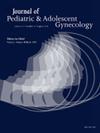Continuation of the Levonorgestrel-Releasing Intrauterine Device Among Adolescents With Endometriosis
IF 1.7
4区 医学
Q3 OBSTETRICS & GYNECOLOGY
引用次数: 0
Abstract
Study Objective
To estimate the 1-year continuation rate of the levonorgestrel-releasing intrauterine device (LNG-IUD) in adolescents with endometriosis, and the frequency at which additional systemic hormonal treatment (HT) is utilized.
Methods
A retrospective cohort study was performed of patients aged 12-21 years who underwent laparoscopy for endometriosis and LNG-IUD insertion at a single tertiary care institution between 2018 and 2021.
Results
We evaluated 224 adolescents (mean age = 17.0, SD = 1.8 years) who underwent LNG-IUD placement during laparoscopic evaluation for endometriosis. Stage I endometriosis was most common (84.4%), followed by stage II (13.0%). Of 221 with follow-up, 208 (94.1%) had HT added or continued postsurgery. The most common additional HT was norethindrone acetate (42.5%), followed by combined hormonal contraceptives (34.8%). The 1-year LNG-IUD continuation rate was 92.0%. There were 18 IUD removals (8%) by 1 year, and the median time to removal was 118 days (interquartile range = 159; range 8-293). Use of additional HT was associated with a lower hazard of IUD removal within the first year of use (hazard ratio = 0.19, 95% confidence interval: 0.06-0.56, P < .001).
Conclusion
The majority of adolescents used the LNG-IUD with additional systemic HT for endometriosis management. While overall continuation was high, adolescents who were using LNG-IUD and HT were more likely to continue LNG-IUD than those who were not utilizing additional HT.
患有子宫内膜异位症的青少年继续使用左炔诺孕酮释放宫内节育器。
研究目的估算患有子宫内膜异位症的青少年使用左炔诺孕酮释放宫内节育器(LNG-IUD)1年的持续率,以及额外使用全身激素治疗(HT)的频率:我们对2018年至2021年间在一家三级医疗机构接受腹腔镜子宫内膜异位症和LNG-宫内节育器植入术的12-21岁患者进行了一项回顾性队列研究:我们评估了224名青少年(平均年龄=17.0岁,SD=1.8岁),他们在腹腔镜评估子宫内膜异位症期间接受了LNG-IUD置入术。I期子宫内膜异位症最常见(84.4%),其次是II期(13.0%)。在 221 例接受随访的患者中,208 例(94.1%)在手术后增加或继续使用 HT。最常见的附加 HT 是醋酸炔诺酮(42.5%),其次是复合激素避孕药(34.8%)。液化天然气宫内节育器的 1 年延续率为 92.0%。1 年内共取出 18 个宫内节育器(8%),取出时间中位数为 118 天(IQR=159;范围为 8-293)。使用额外的 HT 与使用后第一年内取出宫内节育器的较低风险相关(HR = 0.19,95% CI:0.06-0.56,p 结论:大多数青少年在使用液化天然气宫内节育器治疗子宫内膜异位症的同时,还使用了其他系统性 HT。虽然总体持续率较高,但使用 LNG-IUD 和 HT 的青少年比未使用额外 HT 的青少年更有可能继续使用 LNG-IUD。
本文章由计算机程序翻译,如有差异,请以英文原文为准。
求助全文
约1分钟内获得全文
求助全文
来源期刊
CiteScore
3.90
自引率
11.10%
发文量
251
审稿时长
57 days
期刊介绍:
Journal of Pediatric and Adolescent Gynecology includes all aspects of clinical and basic science research in pediatric and adolescent gynecology. The Journal draws on expertise from a variety of disciplines including pediatrics, obstetrics and gynecology, reproduction and gynecology, reproductive and pediatric endocrinology, genetics, and molecular biology.
The Journal of Pediatric and Adolescent Gynecology features original studies, review articles, book and literature reviews, letters to the editor, and communications in brief. It is an essential resource for the libraries of OB/GYN specialists, as well as pediatricians and primary care physicians.

 求助内容:
求助内容: 应助结果提醒方式:
应助结果提醒方式:


